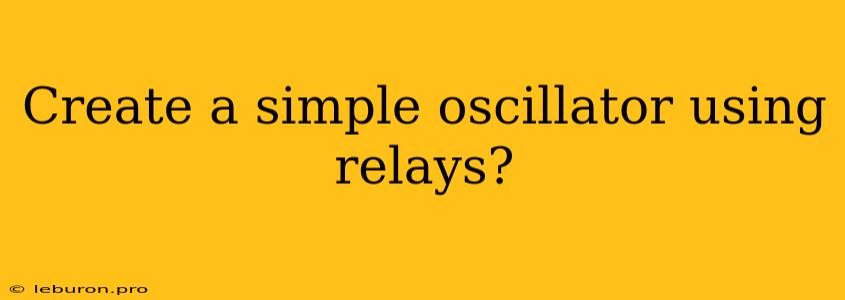Building a Simple Oscillator Using Relays
Relays, often considered simple electrical switches, can be surprisingly versatile components for building electronic circuits. One fascinating application is their use in creating oscillators, devices that produce periodic waveforms. This article explores the fundamental principles behind creating a simple oscillator using relays, delving into the circuit design, operation, and its potential applications.
Understanding the Basics of Relays
Before diving into the oscillator circuit, it's crucial to grasp the fundamentals of relays. A relay is an electromagnetic switch that uses an electromagnet to control the opening and closing of electrical contacts. When an electrical current flows through the coil of the relay, the electromagnet is energized, attracting the armature and closing the contacts. The contacts can then control a separate electrical circuit, allowing the relay to act as a remotely controlled switch.
The Relay Oscillator Circuit
The core of a simple relay oscillator lies in the feedback loop created by the relay itself. The circuit typically comprises the following components:
- Relay: A single-pole, double-throw (SPDT) relay is the most common choice for this application.
- Power Supply: A DC power supply is used to energize the relay coil and the circuit.
- Resistors: Resistors are used to limit current flow and provide proper biasing.
- Capacitor: A capacitor is connected in parallel with the relay coil, playing a crucial role in the oscillation process.
Circuit Operation:
-
Initial State: When the circuit is powered up, the capacitor is initially uncharged. The relay coil is not energized, and its contacts are in their normally open position.
-
Charging the Capacitor: Current starts flowing through the resistor and charges the capacitor.
-
Relay Activation: As the capacitor charges, the voltage across it increases. Once the voltage reaches a certain threshold, the relay coil is energized.
-
Contact Closure: The energized relay coil attracts the armature, closing the normally open contacts. This closure creates a path for current to flow directly from the power supply to the relay coil, bypassing the resistor.
-
Discharge and Oscillation: Closing the contacts directly connects the power supply to the relay coil, bypassing the resistor. The capacitor begins to discharge through the relay coil. As the capacitor discharges, the voltage across the coil decreases, eventually dropping below the threshold required to keep the relay energized.
-
Relay De-activation: With the voltage dropping below the threshold, the relay de-energizes, and its contacts open. This opens the direct path to the relay coil, forcing the current to flow back through the resistor.
-
Cycle Repetition: The cycle repeats as the capacitor starts charging again through the resistor, leading to another relay activation and the entire oscillation process.
The Role of the Capacitor:
The capacitor plays a crucial role in the oscillation process. It acts as a storage element that determines the time it takes for the voltage across the relay coil to reach the activation threshold. The capacitor's value influences the frequency of the oscillations. A larger capacitor leads to a slower charging and discharging rate, resulting in lower oscillation frequency.
Understanding the Oscillation Frequency
The frequency of the oscillation depends on the time constant of the circuit, which is determined by the values of the resistor (R) and capacitor (C). The time constant (τ) is calculated as:
τ = R * C
The oscillation frequency (f) can be approximated by:
f ≈ 1 / (2 * τ)
This equation suggests that the oscillation frequency is inversely proportional to the time constant. Therefore, a larger time constant (resulting from larger R or C values) leads to a lower oscillation frequency.
Practical Considerations and Applications
-
Choice of Relay: Selecting the appropriate relay is essential for the oscillator's performance. The relay's coil resistance and switching current must be compatible with the power supply and circuit design.
-
Power Supply Considerations: The power supply voltage must be suitable for the relay coil and ensure proper operation of the circuit.
-
Circuit Stabilization: The oscillator's frequency can be affected by factors like temperature changes and component tolerances. Adding a stabilizing circuit using feedback mechanisms can enhance the oscillator's stability.
Applications:
Relay oscillators find applications in various fields, including:
- Timing Circuits: They can provide simple timing mechanisms for controlling the duration of events.
- Intermittent Control: Relay oscillators can be used to create intermittent control systems, like turning a light on and off at regular intervals.
- Frequency Generation: While not as precise as dedicated oscillators, relay oscillators can be used for basic frequency generation purposes in low-frequency applications.
Conclusion
Building a simple oscillator using relays is a fascinating demonstration of the versatility of these seemingly basic components. By understanding the fundamental principles of relay operation and the role of the capacitor in the circuit, you can create an oscillator that generates periodic waveforms. While not as precise as dedicated oscillators, relay oscillators offer a simple and cost-effective solution for timing and control applications.
